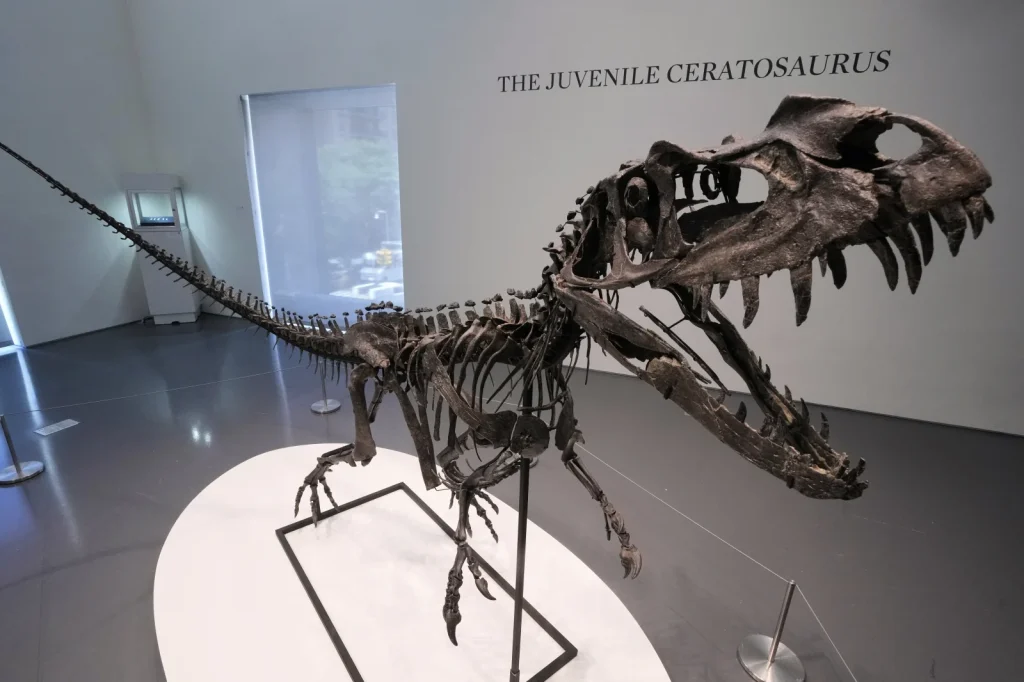On a hot summer morning in New York City, amid the rumble of yellow cabs and the low hum of sidewalk chatter, something almost prehistoric stalks the polished floors of Sotheby’s. It isn’t a new avant-garde sculpture or an experimental installation by a contemporary artist — though it may as well be. It is a mounted skeleton of a juvenile Ceratosaurus, an apex predator from the Late Jurassic, posed in a frozen dance of ancient menace.
This Ceratosaurus, estimated at a hammer price between $4 and $6 million, is the centerpiece of Sotheby’s “Geek Week” auction, scheduled for July 16, 2025. The sale is a celebration of highbrow nerd culture, encompassing rare comic books, vintage tech prototypes, meteorites, and of course, fossils. Yet, it is the dinosaur — particularly this juvenile Ceratosaurus — that commands a visceral fascination unmatched by any other lot.
The Dinosaur in the Room: Ceratosaurus and Its Significance
The Ceratosaurus is an icon of the Late Jurassic, a period that unfolded approximately 154 to 149 million years ago during the Kimmeridgian Stage. Known for its prominent nasal horn and blade-like teeth, the Ceratosaurus was both a symbol of raw predatory power and evolutionary experimentation. Unlike its more robust relative Allosaurus, Ceratosaurus boasted a slender, almost crocodilian tail and a lighter, more graceful build, making it a more agile hunter.
This specific specimen, a juvenile, brings additional layers of intrigue. Juvenile fossils are exceedingly rare because young dinosaurs were more vulnerable to predation and environmental threats, and their lighter, more fragile bones often failed to fossilize fully. That this skeleton survived the ages in such remarkable condition is a scientific marvel. The Sotheby’s specimen provides a crucial glimpse into the growth stages of Ceratosaurus, offering paleontologists and enthusiasts alike a rare opportunity to study its developmental morphology.
From Badlands to Billionaires: The Journey of a Fossil
Before arriving at Sotheby’s, this juvenile Ceratosaurus likely spent tens of millions of years entombed in the silty sediments of what was once a floodplain. It may have been discovered in the Morrison Formation, a geological treasure trove stretching across the western United States. This formation has yielded some of the most famous dinosaur fossils, from Stegosaurus to Diplodocus.
The excavation process is laborious and painstaking. Teams of paleontologists and fossil preparators work in grueling conditions, slowly removing matrix rock with small chisels and air scribes. Each bone is jacketed in plaster for safe transport — a practice that has remained largely unchanged since the 19th century. Once in the lab, these bones are meticulously cleaned, repaired, and sometimes reconstructed from fragments, before being assembled into a mount that brings the ancient creature back to life.
The transition from scientific specimen to auction house lot is itself controversial. Critics argue that commercializing fossils removes them from public and academic study, potentially severing valuable scientific data. Proponents, however, see these sales as a way to fund further paleontological research and to place fossils in private collections where they can be appreciated in new contexts. Sotheby’s, ever the cultural barometer, stands at the intersection of this debate.
The Aesthetic of Deep Time
As the Ceratosaurus skeleton stands under the sleek gallery lighting, its dark, fossilized bones cast eerie background on the walls. The juxtaposition is striking: the ancient predator frozen in dynamic motion, surrounded by minimalist architecture and the vague reflection of urban skyscrapers through frosted glass. This setting recontextualizes the dinosaur from a relic of deep time to an object of contemporary desire.
The skull, with its serrated teeth and haunting orbital cavities, becomes a memento mori for the Anthropocene — a reminder of the transient nature of species, including our own. The long tail curves elegantly, almost balletic, contrasting sharply with the heavy, clawed feet planted firmly on the white platform. The anatomical details — each vertebra, rib, and phalanx — narrate a story of evolutionary experimentation, adaptation, and eventual extinction.
This is not just a display of paleontological interest but an art piece in its own right, channeling both natural history and sculptural beauty. The mount design emphasizes movement and predatory poise, inviting viewers to imagine the creature lunging forward, alive and breathing, in a primordial floodplain dotted with ferns and cycads.
The Allure of Owning Deep History
What drives someone to pay millions for a dinosaur skeleton? Beyond the aesthetic fascination, it is about owning a fragment of earth’s history that predates human civilization by hundreds of millions of years. It is about curating a private connection to deep time, something that dwarfs all modern human achievements and anxieties.
Collectors of dinosaur fossils often describe them as “ultimate trophies,” transcending the typical categories of art or haute. Unlike paintings or jewelry, a fossil is not crafted — it is discovered. It is a singular, irreplaceable artifact that bears the signature of deep geological processes, rather than human hands. To own such an object is to possess an echo of a vanished world, a perspective-altering symbol that challenges the linear narrative of human progress.
This perspective aligns closely with the growing popularity of “experiential luxury,” where status is conveyed not by mere display of wealth, but by access to unique experiences and objects imbued with profound stories.
Public vs. Private: The Ethical Quagmire
However, the auctioning of scientifically significant fossils inevitably raises ethical questions. Museums and universities often lack the funding to compete with wealthy private buyers, leading to the risk that crucial specimens disappear into private vaults, away from public view and academic study. Some countries have banned the export and sale of fossils for this reason, hoping to protect their paleontological heritage.
Sotheby’s addresses these concerns by emphasizing the importance of transparency and provenance. In the case of the Ceratosaurus, its documented history and legal excavation permit it to be sold internationally. Yet, the debate persists: should such a culturally and scientifically vital object belong to an individual, or to the collective heritage of humanity?
Geek Week and the New Cultural Economy
Sotheby’s Geek Week is a microcosm of how “nerd culture” has transitioned from niche to mainstream. Once relegated to dimly lit comic shops and basement fossil shows, these objects of obsession are now celebrated in high-end galleries and prestigious auctions. The convergence of pop culture, science, and art reflects a larger societal shift — an embrace of intellectual curiosity as a form of cultural capital.
The inclusion of the Ceratosaurus skeleton alongside comic books, first-edition video game consoles, and meteorites creates a narrative arc that celebrates exploration, discovery, and imagination. It transforms the auction into more than a marketplace — it becomes a curated celebration of human wonder.
The Future of Fossil Auctions
As fossil auctions become more frequent and headline-grabbing, the art and science communities will continue to wrestle with questions of access and preservation. Future collectors may increasingly be encouraged (or required) to loan or donate their acquisitions to museums or research institutions. Meanwhile, auction houses may adopt new models that allow public exhibitions of sold specimens, fostering a hybrid between private ownership and public engagement.
There is also potential for digital technology to play a role. High-resolution scans and 3D-printed replicas can provide scientists and educators access to important fossils, even when originals are held privately. However, these digital surrogates, while valuable, can never fully replace the awe of standing before the authentic bones of an ancient predator.
Impression
As the juvenile Ceratosaurus stands poised in Sotheby’s gallery, its empty eye sockets stare across time and culture, silently roaring against the clamor of the modern world. In the reflections of polished floors and the buzz of New York outside, it is both out of place and perfectly at home — a ghostly emissary from a vanished epoch, now entangled in the circuits of contemporary luxury and status.
Either it lands in a private collection, a corporate lobby, or a philanthropic loan to a public museum, this Ceratosaurus skeleton embodies a powerful paradox. It is at once a fossil and a fashion statement, a scientific specimen and a sculptural masterpiece, an artifact of extinction and a symbol of human longing to possess and understand what came before.
In an era defined by rapid technological acceleration and environmental uncertainty, the presence of a Jurassic predator in a Manhattan showroom forces us to confront the deep temporality of life on Earth. It asks us to consider what it means to collect, to preserve, and ultimately, to remember.
No comments yet.








